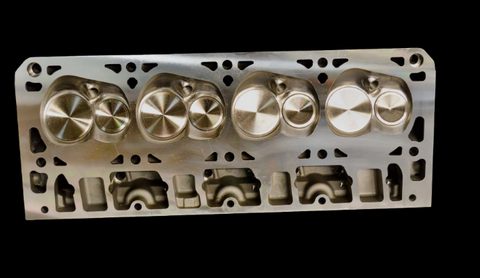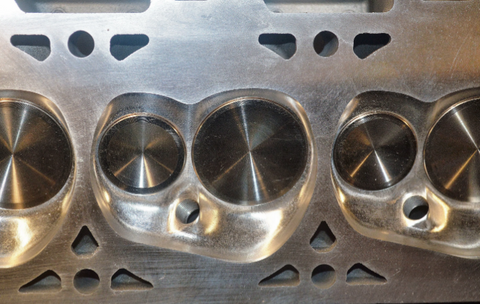
If you want to deliver real power and performance to your Pontiac or Camaro sports car (a guide to compatible vehicles is given below), the 823-cylinder head is a great addition.
First launched in 2008, installed in the C6 Corvette, General Motors’ LS3 series of engines took the power of their compact racers up to 430 horsepower and beyond. The new head castings were basically a reduced-size version of the LS7, first fitted on an Australian Escalade model in 2007.
The 6.2L, 376ci debut LS3 model demonstrated a firm commitment to power. Strongly built yet compact and lightweight, they kept a generation of speed enthusiasts happy until 2017. You’ll find these blocks in every GM brand of the era from GMC, Cadillac, and Pontiacs to Hummers and even Isuzu vehicles.
Why Choose the 823?
There are several cylinder heads available for the LS3 block, but not all are made equal. Let’s talk though some specs of the 823 first (also known as an L92 head). The three-digit number refers to the casting process that created the single piece of metal that constitutes the head.
The 823 cylinder head has a chamber of 65cc (cathedral style ports) or up to 70cc with the more commonly encountered rectangular ones. To produce the power these heads are noted for, the head has a very large intake port (257cc, 2.165-inch diameter) and an exhaust port capacity of 87cc (1.59-inch diameter).
With advanced porting (such as those using CNC, or Computer Numerically Controlled methods), turbo-charging, and other modifications, vehicles with 823 heads have attained 1000 horsepower or more.
What makes the 823 unique?

Here’s a quote from enthusiast site LS Engine DIY: “Though sacrifices were made for emissions, you won’t find a higher-flowing head for the money.” In effect, General Motors found the sweet spot between price, power, and performance with this build.
Another performance altering modification on the 823 head, from its predecessor, the 821, is that the valves have a 2-angle shape, rather than 3-angles, improving air and exhaust flow. A compression ratio of 10:1 is normal for a stock build, but this can be increased significantly with modification.
The head unit is cast from aluminum, making it lighter than iron and capable of higher temperatures within the combustion chamber. Another advantage of the LS3 series in general is its excellent valvetrain, which incorporates a beehive spring and hydraulic rollers for maximum responsiveness at speed.
As Motortrend wrote: “When GM introduced the LS3-based rectangular port heads they were the best flowing small-block heads ever offered on a production vehicle.” They have since been surpassed by the likes of LS7 heads for 7L engines, but the LS3 series, including the 823 cylinder head remains an all-time design classic.
What automobile engines will take an 823 head?
Vehicles which should accept an unmodified 823 cylinder L92 head include any GM model built between 2008 and the late 2010s, as well as any car previously fitted with an 821 cylinder head or a 5346 fit. If in doubt, do ask your supplier or mechanic.
Comparing Heads
Now let’s look at some comparisons. Below, we’ve compared the 823 to some of its most frequent competitors.
823 vs 243 heads
The popular L6 243 heads have a smaller capacity (64cc), whereas the 823’s larger intake valve has a 70cc cylinder, promoting better overall flow within the combustion chamber.
In addition, there’s some controversy among gearheads about whether the “swirl” ramp added to the 243 to improve fuel and air mix in the combustion chamber actually works. Many have this part milled down or removed, finding that it can cause unwanted turbulence.
823 vs 821 heads
These heads have basically the same build but different spring and valve technology. The valves and springs on an 821 are a little lighter than an 823, as much as 19g. This might matter if you’re trying to shave off additional weight for racing performance, but won’t make much difference to the typical road user.
823 vs 799 heads
799 heads have a cathedral port shape (with a point at one end) which delivers improved performance down low, but for top end sportiness, stick with 823s.
Incidentally, 799 heads are essentially identical to 243 heads, but the 243 casting has a smoother finish.
823 vs 706 heads
Similar to the 799s, the 706 will deliver better performance up to around 4000rpm. However, for racers willing to spend a little more money, the 823 LS3 cylinder heads are fantastic all-rounders.
The Final Verdict
In terms of performance, price and flexibility, the 823 cylinder head for LS3 engines scores highly. In fact, on all the gearhead forums, it’s hard to find a negative work spoke about this iconic and all-important component.
Check out our Allied Motor Parts 823 L3 cylinders at low, low prices today.
Related Products of LS3 Cylinder Heads:
CNC Ported LS3 364/823 Cyl Heads .650 Springs 2.16/1.59 Valves PAIR
NEW CNC Ported LS3 Cyl Heads .650 Springs 2.16/1.59 Valves PAIR
Check out Our Other Articles:
All About 243 LS Heads & Their Application
Are 862 Heads a Better Choice?
Why Chevy 706 Heads LS Make a Great Choice?
13 Step Process for Remanufacturing Cylinder Heads
Ford V10 Cylinder Head Replacement
Cylinder Heads for the Chevrolet 350 - What You Need to Know
Vortec Engine History and Cylinder Heads
Vortec Engine History and Cylinder Heads




